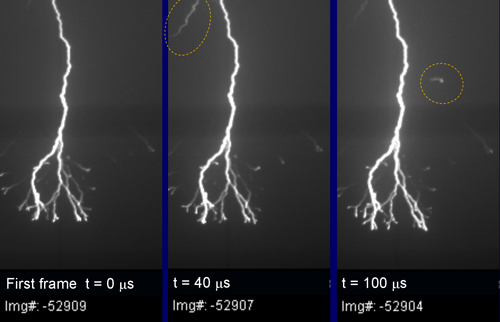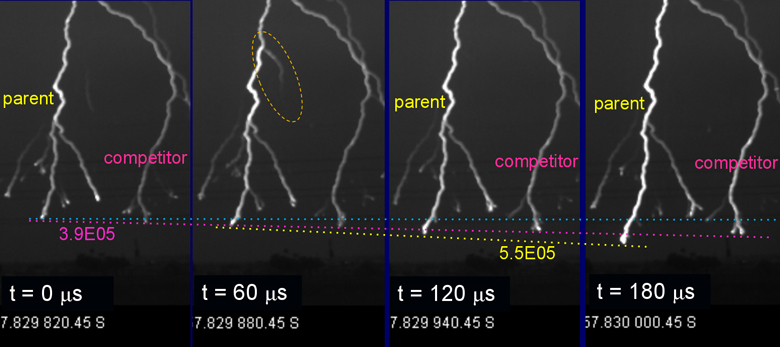The rise of high-speed video over the past several years has allowed scientists to study lightning in unprecedented detail. In one of the latest findings, researchers have documented fleeting flare-ups, which they’ve dubbed “sparks,” that rekindle previously abandoned paths visited by jagged blazes of lightning plunging to Earth.
When cloud-to-ground lightning propagates, it doesn’t take a straight path. Instead, it follows a zigzag channel through the air, known as a stepped leader, which forms after strong electric fields ionize gas molecules, creating a highly conductive plasma. The stepped leader—which is invisible to the naked eye but can be seen by sensitive high-speed video cameras—extends itself in segments about 50 meters long apiece, often changing direction and splitting into many ancillary branches because the conductivity of the air is not uniform. A similar channel simultaneously takes shape from below until the two meet. That’s when a powerful upward current of electric charge, called the return stroke, surges through the channel, causing the dazzling flash we know as lightning.
Many of the branches that shoot off the main stepped leader trunk go dark before the leader reaches the ground. But sometimes, these abandoned branches suddenly spark back on again, reconnecting to their parent, according to new observations from Maribeth Stolzenburg, an atmospheric physicist at the University of Mississippi in Oxford, and her colleagues.
Surprisingly Common Sparks
“It’s a little surprising to us that no one has described these previously.”
“It’s a little surprising to us that no one has described these previously because we see them in all stepped leaders,” Stolzenburg said. She presented her findings last month at the meeting of the European Geosciences Union (EGU) in Vienna. She also described the phenomenon last year in a paper in the Journal of Geophysical Research: Atmospheres.
The findings are based on data Stolzenburg and her colleagues collected at Kennedy Space Center in Florida during a fruitful 6-week field season in 2011. Because stepped leaders can’t be recreated in rocket-triggered lightning experiments, researchers must go to a place where natural lighting is common.

“In 2011, we had storms probably 3 out of 5 days, so it was a pretty active spot,” Stolzenburg said of her field site. “We pretty much filled the camera memory every time we ran it.” That’s perhaps not so surprising, considering that just one trigger of their high-speed camera, recording at 50,000 frames per second, could create a file as large as 18 gigabytes.
In total, the team recorded 34 stepped leader systems from a maximum distance of 15 kilometers. The scientists reported that all 34 of these stepped leaders had at least one and as many as 15 visible sparks.
Examining the Flash
Because the high-speed video could capture changes along the lightning’s path lasting as little as 20 microseconds, the observers could distinguish sparks from stepped leader branches still growing or just brightening or dimming, Stolzenburg told Eos. “These are really features that have stopped propagating and are basically abandoned,” she added. “There’s probably lots and lots of these that never light up as sparks, but the few that do are pretty prominent features.”
Stolzenburg and her colleagues suspect sparks occur when the potential difference, or voltage, across the gap between the cutoff branch and the active leader becomes strong enough to suddenly discharge.
The existence of sparks could help researchers make sense of some lightning observations that have never really had good explanations, Stolzenburg said. For example, sparks might explain why the lowermost tips of some stepped leaders suddenly accelerate as they get closer to the ground. When a spark occurred, the researchers observed that the parent leader zoomed faster, sometimes by as much 109%.
This acceleration became especially apparent when a spark reconnected to a stepped leader and the leader suddenly beat a competing leader to the ground. The researchers also saw that the parent leader to which a spark reconnected would brighten by 5%–50% below the reconnection point.

As Seen in New Mexico
The research “certainly says something new about lightning.”
The research “certainly says something new about lightning and how the leader stepping goes,” Harald Edens, a lightning researcher at the New Mexico Institute of Mining and Technology in Socorro, who was not involved in the study, told Eos. “It says a little bit more about what the voltage potential is doing along the channel and how the charges are moving, which is really not very well understood.”
Edens, who attended Stolzenburg’s talk at EGU, thinks he has seen the same sparks in stepped leaders. He wrote about his observations—made with the high-speed cameras at the mountaintop Langmuir Laboratory for Atmospheric Research just west of Socorro—in his dissertation back in 2011. However, he hasn’t published those findings in a journal.
“I was very happy to see that someone saw what I think is the same phenomenon that we have seen at Langmuir Lab,” Edens said. “What she described was very similar to what we have seen. To me it made total sense.”
—Megan Gannon, Freelance Writer; email: [email protected]
Citation: Gannon, M. (2016), Scientists find dead lightning branches that come back to life, Eos, 97, doi:10.1029/2016EO052405. Published on 17 May 2016.
Text © 2016. The authors. CC BY-NC-ND 3.0
Except where otherwise noted, images are subject to copyright. Any reuse without express permission from the copyright owner is prohibited.

